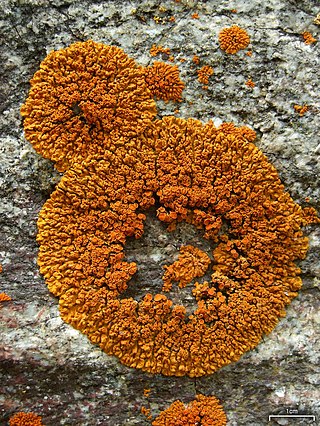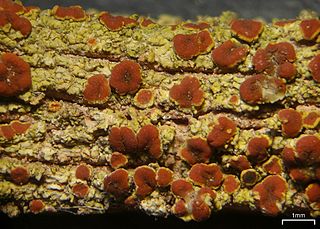Sedelnikovaea is a genus of placodioid lichens in the family Lecanoraceae. The genus was circumscribed in 2015 by Sergey Kondratyuk, Min-Hye Jeong, and Jae-Seoun Hur to contain Sedelnikovaea baicalensis, the type species. Three additional species were transferred into the genus in 2019.
Caloplaca kedrovopadensis is a little-known species of crustose lichen in the family Teloschistaceae. It is only found in the Kedrovaya Pad Nature Reserve in the Russian Far East, and on the Jiri Mountain of South Korea. The lichen has been recorded growing on rocks and on bark.
Lecanora ussuriensis is a species of saxicolous (rock-dwelling) lichen in the family Lecanoraceae. It is found in single localities in the Primorsky Krai region of the Russian Far East, as well as in Japan.
Opegrapha verseghyklarae is a little-known species of lichenicolous (lichen-eating) fungus in the family Opegraphaceae. It is found in the Russian Far East, where it grows on the thalli and apothecia of the crustose lichen Ochrolechia pallescens.
Lecidella mandshurica is a species of corticolous (bark-dwelling), crustose lichen in the family Lecanoraceae. It is found in the Russian Far East, South Korea, and China.
Lecanora lojkahugoi is a species of saxicolous (rock-dwelling) crustose lichen in the family Lecanoraceae. It is found in the Russian Far East and in South Korea.
Biatora oxneri is a species of corticolous (bark-dwelling) lichen in the family Ramalinaceae. It is found in the Russian Far East and in South Korea.
Klára Anna Verseghy was a Hungarian lichenologist. She was the curator of the lichen collection of the Hungarian Natural History Museum in Budapest from 1958 to 1985.
Neobrownliella is a genus of crustose lichens in the subfamily Teloschistoideae of the family Teloschistaceae. It has five species. The genus was circumscribed in 2015 by lichenologists Sergey Kondratyuk, Jack Elix, Ingvar Kärnefelt, and Arne Thell, with Neobrownliella brownlieae assigned as the type species. It is a segregate of the large genus Caloplaca. Characteristics of Neobrownliella include a thallus that is continuous or areolate, the presence of anthraquinones as lichen products, a cortical layer with a palisade paraplectenchyma, and the lack of a thick palisade cortical layer on the underside of the thalline exciple. Two species were included in the original circumscription of the genus; an additional three species were added in 2020.

Golubkovia is a single-species genus in the family Teloschistaceae. It contains the species Golubkovia trachyphylla, a crustose lichen. The genus was circumscribed in 2014 by Sergey Kondratyuk, Ingvar Kärnefelt, John Elix, Arne Thell, and Jae-Seoun Hur. The generic name honours Russian lichenologist Nina Golubkova (1932–2009), who, according to the authors, "made important contributions to lichenology in northern Eurasia".
Kashiwadia is a genus of lichen-forming fungi in the family Physciaceae. The genus was circumscribed in Sergey Kondratyuk, László Lőkös, and Jae-Seoun Hur in 2014 to contain the species Physcia orientalis, after molecular phylogenetic analysis showed that the taxon occupied an isolated phylogenetic position in the Physciaceae. An additional five species were added to the genus in 2021. The genus name honours Japanese lichenologist Hiroyuki Kashiwadani, who originally described the type species.

Verseghya is a genus of lichen-forming fungi in the family Pertusariaceae. It has two species. The genus was circumscribed in 2016 by lichenologists Sergey Kondratyuk, Laszlo Lőkös, and Jae-Seoun Hur, with Verseghya klarae assigned as the type species. This crustose species is found in South Korea, where it grows on the bark of a wide variety of both deciduous and coniferous trees. Molecular phylogenetic analysis showed that Verseghya klarae occupied a separate phylogenetic branch in the Pertusariaceae, situated between the genera Ochrolechia and Pertusaria and the Lecanora subcarnea species complex. Verseghya thysanophora was transferred to the genus in 2019. It is widely distributed in the Northern Hemisphere.

Tomnashia is a genus of lichen-forming fungi in the family Teloschistaceae. It has four species of saxicolous (rock-dwelling), crustose lichens that occur in southwestern North America.

Opeltia is a genus of lichen-forming fungi in the family Teloschistaceae. It has four species of corticolous (bark-dwelling), crustose lichens.
Klauskalbia is a genus of lichen-forming fungi in the family Physciaceae. It has four species of foliose lichens.
Fauriea is a genus of lichen-forming fungi in the family Teloschistaceae. The genus, which contains seven species, is a member of the subfamily Caloplacoideae.
Marchantiana is a genus of lichen-forming fungi in the family Teloschistaceae. It contains seven species of corticolous (bark-dwelling), crustose lichens that occur in the Southern Hemisphere.
Rehmanniella is a genus of lichen-forming fungi in the family Teloschistaceae. It contains five species of saxicolous (rock-dwelling) crustose lichens. The genus was circumscribed by lichenologists Sergey Kondratyuk and Jae-Seoun Hur in 2018. The genus name honours Polish geographer, geomorphologist, botanist and explorer Anton Rehmann (1840–1917), who collected bryophytes and vascular plants in South Africa. The genus was originally circumscribed with Rehmanniella wirthii assigned as the type and only species. Four additional species were added to the genus in 2020.
Orientophila is a genus of lichen-forming fungi in the family Teloschistaceae. It has 15 species of mostly saxicolous (rock-dwelling), crustose lichens. All Orientophila species occur in Northeast Asia including China, Japan, South Korea, and the Russian Far East.
Olegblumia is a monotypic fungal genus in the family Teloschistaceae. It contains the single species Olegblumia demissa, a saxicolous (rock-dwelling) crustose lichen.



